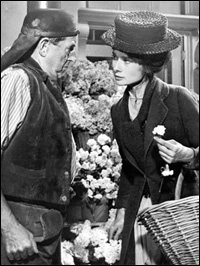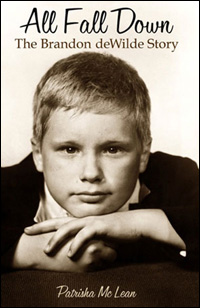
*
The word "scholarly" appears three times in the first two pages of Dominic McHugh's explanatory preface to Loverly: The Life & Times of My Fair Lady [Oxford], and the first paragraph of the book proper cites Ovid, Dryden, Goethe, Rodin, Goya, William Morris (the 19th century designer/writer, not the theatrical agent), Shelley, Rameau, Cherubini, Donizetti and even Kurt Weill before it gets to George Bernard Shaw.
And there, in a way, is the gist of it. If you want a scholarly account of the creation of Lerner & Loewe's My Fair Lady, here it is. McHugh seems to have developed this book from his doctoral thesis at King's College, London. While I don't have much experience with doctoral theses, I suppose this made a fine one. As a book about a scintillatingly deft piece of musical theatre, though, it is — shall we say — drily academic.
McHugh has done a protean job digging through archival material, in this case being mostly the office files of producer Herman Levin at the Wisconsin Historical Society and the extensive musical holdings at the Music Division of the Library of Congress. He has also plumbed other collections — including those of the Theatre Guild — to piece together the pre-My Fair Lady attempts at musicalizing Shaw's "Pygmalion." And, just as importantly, the battles to secure the rights to the same.
This last makes a fascinating tale, if you are keen on such things (as I am); if not, though, you might have trouble keeping the various parties and the numerous developments straight. (Somehow or other, the ultimate resolution — with Levin as the surprising winner of the rights — is tied up with Li'l Abner, and don't ask me to explain how without rereading the thing.) Highly interesting to those of us who have worked in theatrical producing and management — as is the disposition of the original London stage rights — but little to do with the musical itself.
 |
||
| Julie Andrews and Rex Harrison in My Fair Lady. |
There is, similarly, in-depth discussion about changes in the script, changes in the dialogue, changes in lyrics, and changes in music. McHugh pores over outlines and scripts, comparing them all to each other and to the dramatic and cinematic versions of "Pygmalion." He also goes through countless musical manuscripts — sketches, piano-vocal scores, rehearsal scores, full orchestral scores — and tries to piece together which was written when, why this one is in Loewe's hand and that one is in Trude Rittman's hand, and what is the overall significance of this, that or the other. Scholarly, yes, but I suspect of limited interest — and in cases indecipherable — to most readers. Take a sentence like "it is intriguing that Bennett's orchestration of this section follows Rittmann [sic] in writing the bass part as a D-flat major arpeggio (a false relation) rather than its enharmonic, C-sharp major, as in Loewe's manuscript (again, probably a fair copy)." Intriguing to you, maybe.
There are 74 pages of this. And oddly enough for a scholarly tome, the author misspells "Rittman" throughout the book. (Trude Rittman was a rehearsal pianist whom Agnes de Mille discovered in the ballet world and set to work on One Touch of Venus and Carousel. She was one of the best in the business, as attested to by the powerful incidental music in the "Twin Soliloquies" and "Younger Than Springtime" scenes of South Pacific; "The Small House of Uncle Thomas" ballet in The King and I; and the extended music lesson within the "Do Re Mi" number in The Sound of Music. Loewe, Rittman and My Fair Lady conductor Franz Allers were close buddies; Trude called Loewe "Fritzie.")
 |
||
| Stanley Holloway and Audrey Hepburn in the 1964 movie. |
||
| Warner Bros. |
McHugh spends no less than 16 full pages discussing a 15-minute sequence at the end of the first act, which was immediately cut during the New Haven tryout. This included Eliza's solo as she prepared for the ball, "Say a Prayer for Me Tonight" (which resurfaced in Gigi); a full-scale "Dress Ballet"; and "Come to the Ball," with which Higgins sweeps Eliza off to the Embassy. What was all this? What, precisely, happened in the ballet? Why was it cut? Was the sequence any good? We get all sorts of guesses, as McHugh industriously tries to piece things together using scraps found in the archives like a page of preliminary notes from choreographer Hanya Holm suggesting required costume pieces for the dancers. But why, if he's attempting the definitive book on My Fair Lady, didn't he just ask Biff?
My Fair Lady has gone down in the annals as one of Broadway's all-time greats, setting a record for long-running musicals. (It broke the mark set by the 1943 Oklahoma!, being surpassed in turn by the 1964 Hello, Dolly!). But My Fair Lady was neither artistically groundbreaking nor overly influential; it was simply an impeccable musical of its time. Nowadays, when 1950s musicals like Guys and Dolls, The King and I, and Gypsy enjoy repeated high-profile productions, My Fair Lady is relatively ignored. Which leads one to wonder just how interested today's readers are in how and why Lerner & Loewe tinkered with Shaw's Higgins & Eliza a half century ago.
Passionate about theatre books? See what the Playbill Store has on its shelves.
 |
||
| Cover art for "All Fall Down: The Brandon de Wilde Story" |
People don't much remember 1950 stage plays, understandably so, or even 1950s film versions of stage plays (unless you're talking A Streetcar Named Desire). De Wilde holds a place in cinema history, though, for his performance in the 1953 classic "Shane." The wide-eyed 11-year-old looking out over the prairie as the gunslinger Shane rides in; that same boy in the final moments, eyes filled with tears, forlornly crying out "Shane! come back!!" These are unforgettable moments, that capture de Wilde at the height of his fame. He received an Oscar nomination, competing against castmate Jack Palance; they lost to Frank Sinatra, for "From Here to Eternity."
De Wilde starred in a second Broadway hit, opposite Helen Hayes in Mary Chase's Mrs. McThing (1952); and in a second important film, the 1963 "Hud" (with Paul Newman, Melvyn Douglas and Patricia Neal). In the latter, the 20-year-old de Wilde played a boy of 16. And that was the end of it. In a typical scenario, the former child actor was unable to sustain a career; everyone wanted that cute little boy, who was no more. In de Wilde's case, it wasn't (initially) a question of money; his father — Fritz de Wilde, longtime production stage manager for Broadway producer Robert Whitehead — carefully saved the boy's earnings. But Brandon aimlessly spiraled into the world of rock music (unsuccessfully) and drugs (with typical results). By 1971, he was lucky to get a job playing Butterflies Are Free in summer stock in Denver. On July 6, 1971, he ran his van into a truck and died, at the age of 29.
All of this is covered in All Fall Down: The Brandon de Wilde Story by Patrisha McLean. The book is a bit odd, written in something of a facile, fan magazine style — which actually works well in this instance. McLean started the project in 1988 as homage to the actor, contacting many of the still surviving people who had surrounded him. The author dropped the project after a few years, stymied by various obstacles including the inability to locate the woman de Wilde married three months before his death.
Twenty years later, McLean decided to finish her book as best she could, before de Wilde was all but forgotten. The day before she sent the manuscript to the printer, she tells us, a priest in Italy emailed with contact information for the widow. Thus, McLean was able to redraft, revise, and fill in some missing pieces. This leaves us a book written over two generations, in two centuries, based on memories from not all that many people (although Julie Harris is, happily, present). Some of the people the author relies on don't seem to have much of import to say, but that can happen when you don't have enough first-hand sources. Despite the decided oddities of this apparently self-published book, McLean really does give us a sense of who that arresting, talented and forlorn boy — "Shane! come back!!" — actually was.
(Steven Suskin is author of the recently released updated and expanded Fourth Edition of "Show Tunes" as well as "The Sound of Broadway Music: A Book of Orchestrators and Orchestrations," now available in paperback, "Second Act Trouble" and the "Opening Night on Broadway" books. He also pens Playbill.com's On the Record and DVD Shelf columns. He can be reached at Ssuskin@aol.com.)
*
Passionate about theatre books? See what the Playbill Store has on its shelves.










